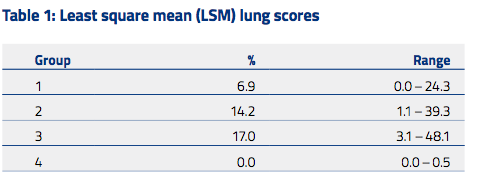



Virulence of Currently Circulating PRRSv Isolates under Experimental Conditions
In 2014 in North Carolina, anecdotal reports of a particularly virulent PRRSV isolate (RFLP cut pattern 1-7-4) were reported by practicing veterinarians.Reports indicated that the isolate was more trans- missible, had higher levels of viremia for longer time periods and was more virulent in comparison to other circulating PRRSV strains. The objective of this study was to evaluate PRRS 1-7-4 isolates under experimental challenge conditions.
MATERIALS AND METHODS
Sixty, PRRSV negative conventional, three week old pigs were ran- domized into four treatment groups (n=15/group). On D0, animals in Group 1 and 2 were inoculated intranasally with 2ml of one of two viral harvests derived from clinical samples collected in 2014 (RFLP pattern 1-7-4; lineage 1); animals in Group 3 were challenged with a positive control isolate (RFLP pattern 1-18-2; lineage 1); animals in Group 4 were inoculated with 1 X PBS. Serum was collected on D0, 1, 3, 5, 7, 14, 21, 28 and 35. On D14, 10 animals from each group were necropsied; remaining animals were necropsied on D35. At the time of necropsy, lungs were scored for macroscopic lesions and broncho- alveolar lavage was collected. Serum samples and BAL were tested by RT-PCR for the presence of PRRSV RNA and by ELISA for the pres- ence of anti-PRRSV antibodies. BAL was cultured for the presence of bacteria.
RESULTS
Least square mean lung lesion scores (with 95 % confidence intervals) at D14 by group are listed in Table 1 below. Group mean cycle quantification values (Cq) on serum samples by day and group are presented in Figure 1. Viremia occurred in 13/15 animals in Group 2 and 3 by D1; all animals became viremic by D3. In Group 1, 13 / 15 animals were viremic by D3; all animals were viremic by D7. Viremia was detectable in all remaining challenged animals at D35. All challenged animals had detectable PRRSV antibodies by D14; antibodies persisted through D35. Animals challenged with placebo material remained seronegative throughout the trial. Additional results were compiled but not reported.


CONCLUSION
Two PRRSV isolates recovered in 2014 from farms experiencing severe clinical signs associated with PRRSV were compared to a virulent PRRSV isolate recovered in 2008. Differences in lung lesions and onset of viremia were observed between the two 2014 isolates, although not when compared to a 2008 isolate within the same lineage.
A. Patterson, G. Haiwick, J. Victoria, J. Hermann, R. Philips
If you want to read more abstracts like this one visit: https://www.prrs.com/en/publications/abstracts/









